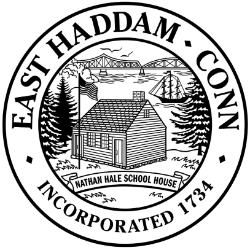Town History


Condensed from A Brief History of East Haddam, Connecticut, written by Dr. Karl Stofko and Rachel Gibbs.
Before 1650
Until 1650, the area of East Haddam was inhabited by at least three tribes of Indians: the Wangunks, the Mohegans and the Nehantics. The Indians called the area “Machimoodus,” the place of noises, because of numerous earthquakes that were recorded between 1638 and 1899. Loud rumblings, the “Moodus Noises,” could be heard for miles surrounding the epicenter of the quakes near Mt. Tom. The land, which is now Haddam and East Haddam, was purchased from the Indians in 1662 for thirty coats – worth about $100.
1650-1700
Layout of the highways began in 1669 with Creek Row about ¼ mile east of the River and Town Street “The Great Highway” about ¼ mile east of Creek Row. The first permanent settlers established homesteads along Creek Row in 1685. These were the John Bates, Cone, Daniel Brainerd, Gates, Nicholas Ackley and Samuel Spencer families. By 1700, there were thirty families living in East Haddam. Thomas Hungerford settled in Hadlyme in 1692, Samuel Emmons and William Spencer established what is now Little Haddam in 1700, and Jonathan Beebe settled in Millington in 1702. The Issac Ackley farm, owned and operated by the same family since the 1700’s, still exists today as Ballek Garden Center. Agricultural and timber farming, shipbuilding, tanneries and blacksmiths were among the early commerce.
1700s
Captain John Chapman began ferry service across the Connecticut River in 1695, which ended with the completion of the swing bridge in 1913. The First Ecclesiastical Society of Haddam East was formed in 1704, which served as both an organization for worship and governance. East Haddam was incorporated as a separate town from Haddam in 1734. By 1756, there were nearly 2,000 residents, with the Millington District as the most populated. Venture Smith, a slave who purchased his freedom, moved to East Haddam in 1774 and became a successful entrepreneur. The school house where Nathan Hale taught during the winter of 1773-4, was originally built in 1750 located in East Haddam Village near what is now the Nathan Hale green. Over 350 men served during the period of the Revolutionary War, with many notable East Haddamites involved in the efforts. The Episcopalian church was established in 1791, with its present church housing the oldest church bell in the U.S. constructed around 1890. The present First Church of Christ, Congregational, was built in 1794 by the First Ecclesiastical Society. The town built a separate meeting house from the church around 1795 atop Mt. Parnassas, then known as Town Hill.
1800s
The growth of commerce brought a surge in population to around 3,000 people by the mid-1800s. Over 400 ships were built in the Green, Warner, Hayden and Goodspeed shipyards on the Connecticut River from the mid 1700’s through 1877. At least 15 manufacturing mills operated along the Moodus River and other areas during the 1800’s. Retail shops, taverns and hotels also flourished. In 1800, East Haddam became a federal post town, with up to six operational post offices in the area during the 1800’s. By 1819, there were nineteen neighborhood schoolhouses throughout the various area of town - Millington, Hadlyme, North Plains, Leesville, Johnsonville, Moodus, Little Haddam, and the East Haddam Landings. The East Haddam Public Library and Reading Room Association was organized in Moodus in 1888, with the present library building donated to the Town in 1920. The present town meeting hall was built in 1857. The Moodus Drum and Fife Corps was organized in 1860 by Hezekiah Percival and East Haddam Grange began in 1887. More than 600 people attending the opening night of the Goodspeed Opera House in October 1877. This was a center of entertainment until its decline in 1920, but then reopened to theatergoers in 1963.
1900s
In 1923, the Nathan Hale School on Town Street was built and by 1940, all students in town attended this one school. The Rathbun Free Memorial Library was built in 1935 through the bequest of Norris Rathbun. The population of the town had declined to about 2,000 residents by 1930. However, visitors and residents such as actor, William Gillette, whose castle home was completed in 1914, were drawn to the area know for its rural charm and natural scenery. The growth of the resort areas of Lake Hayward, Bashan Lake and Moodus Reservoir began in early 1900’s and was a booming business for the next fifty years.
For more information on the history of East Haddam, contact the East Haddam Historical Society, the East Haddam Historic District Commission or Municipal Historian, Dr. Karl Stofko.


